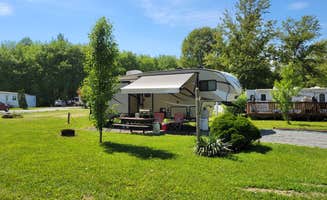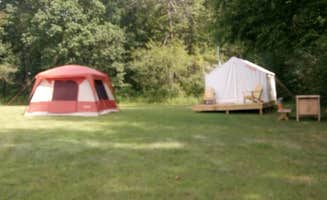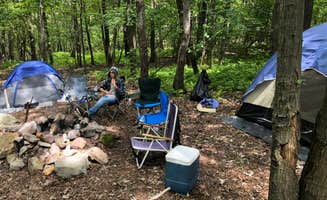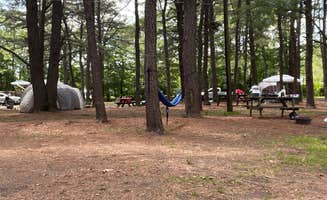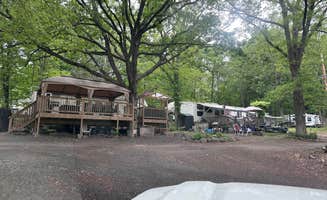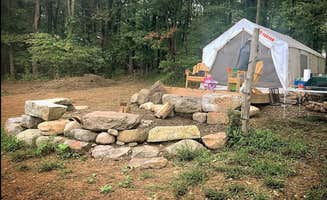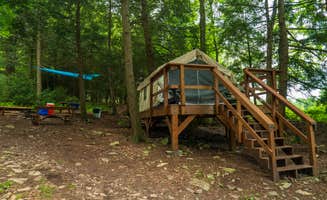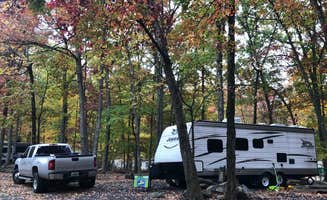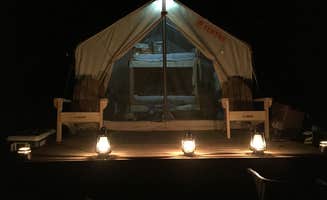Camping near Saylorsburg involves navigating the region's variable summer temperatures, which typically range from 60-80°F with occasional thunderstorms. Located in Monroe County at approximately 700 feet elevation, the area serves as a gateway to both Delaware Water Gap recreation and interior Pocono camping opportunities. Fall camping season typically ends by late October when nighttime temperatures regularly drop below freezing.
What to do
Wolf preserve visits: Camp Taylor Campground offers direct access to the Lakota Wolf Preserve with discounted tours for campers. "The wolf preserve at the same location was just amazing - we learned so much and could hear the wolves howl from the campsite," notes one visitor who also hiked to Mt. Tammany directly from the campground.
Boulder field exploration: Hickory Run State Park features a remarkable boulder field that draws visitors year-round. "The Boulder Fields are one of the coolest places I've ever visited, partially because they were so unexpected. Don't twist an ankle, but you can play hide and seek to an extent as there are small depressions in the fields," shares a camper who appreciated this unique geological formation.
Water recreation: Tobyhanna State Park offers paddleboats, kayak rentals, and lake swimming from late spring through early fall. "Scenic state park with a lake. You can swim in the lake in the summer or do a 5-mile hike around the lake along well-marked walk paths," explains a visitor who also noted the convenient multiple parking lots without fees.
What campers like
River access sites: Driftstone Campground receives consistently positive feedback for its waterfront locations. "Driftstone is set on a beautiful location on the Delaware River. River Road on which it is located, is picturesque and quiet enough to run, walk or bike on. The sites along the river would be my first choice," states a regular visitor who appreciates the easy access to boating and swimming.
Secluded wooded sites: Cranberry Run Campground offers tent sites with greater privacy than many area campgrounds. "The hike in spot is about 5 minutes from the parking spot. Very secluded, price isn't that bad and the staff is friendly," reports a camper who valued the isolation despite the short walk required.
Mountain views: Several campgrounds provide scenic overlooks of the surrounding Pocono region. "We had a pretty large group with grandma in tow so the staff put us near a restroom with full plumbing for convenience, greatly appreciated. We were also right at the bottom of a trail that lead straight up the mountain with beautiful sites and of course photo opportunities for my family and I," shares a family who enjoyed the terrain at Cranberry Run Campground.
What you should know
Bear activity: Bears are common throughout the camping areas near Saylorsburg. "Just stayed 2 nights with my 7 yrs. old daughter we had a blast... We were warned at check in that there have been a lot of bears in the area but never really thought that we would see one. As soon as we got to our site one came right up as we were setting up our tent. Do not leave any food out be sure to lock up everything in car," warns a visitor to Tobyhanna State Park.
Quiet hour enforcement: Campgrounds vary significantly in their noise policies. "My daughter and I have made Camp Taylor our annual spot for the past 4-5 years and it just keeps getting better... Plus, unlike many other campgrounds we've been to, they are very good about actually enforcing the quiet hours at night, so you can have an actual peaceful and quiet night around the campfire," notes a regular visitor.
Site variations: Even within the same campground, site quality and privacy can differ dramatically. "The RV spots that are each cut out in the woods are very private. Once you have backed into the spot and leveled out it's a good time. The section of spots toward the back by the pond are usually packed and lots of activity and early morning active children," explains a visitor to Camp Taylor Campground.
Tips for camping with families
Swimming options: Multiple swimming areas cater to different preferences and age groups. "The swimming pond is pleasant and great to cool off in. The bathrooms/showers are clean and well maintained. The small mini-golf course is a fun distraction for a bit," reports a family visiting Camp Taylor Campground.
Playground access: Mountain Vista Campground has expanded family facilities. "This campground is very clean, staff and campers are very friendly. It's a great spot if you have kids because they have many different activities (pool/arcade games/movie nights/ and more)," shares a visitor who appreciated the range of child-friendly amenities.
Scheduled activities: Several campgrounds offer organized events, especially on summer weekends. "We've tried to camp at least one weekend a month from spring through fall and try different places, but we always come back to Mountain Vista! The staff is friendly and helpful and they have a ton of great activities from kids carnival, craft beer tastings, farmers market, bingo...the list goes on!"
Tips from RVers
Road access considerations: Some campgrounds have challenging approaches for larger rigs. "PLEASE NOTE: if you are towing or have a motorhome, make sure you follow the directions on the website. Coming in from the wrong road could lead you to a hairpin turn and steep hill," warns a visitor to Driftstone Campground who appreciated their spacious waterfront sites once arrived.
Site leveling challenges: Many of the best places to camp near Saylorsburg, Pennsylvania require careful leveling. "Sites are dirt/grass and are not level, but they are long which makes up for the front to back level issue," notes an RVer at Pocono Vacation Park, highlighting a common condition in the mountainous terrain.
Hookup variations: Campgrounds differ in their electrical and water service. "We camped at site C-14 a gravel semi-level site. Our hookups are on the driver's side but the way they have their water, electric and sewer, we had to pull in forward in order to hookup," explains a visitor to Silver Valley Campsites who had to adapt their standard setup procedure.


